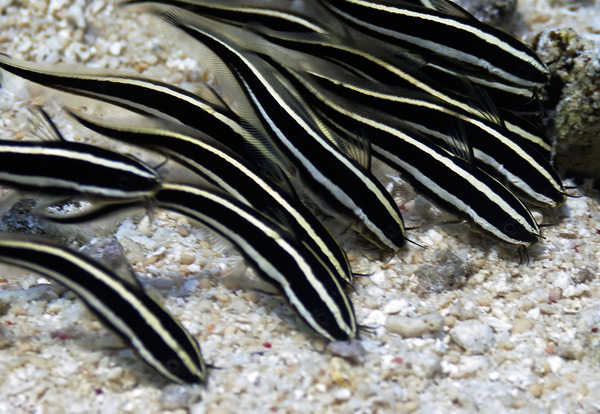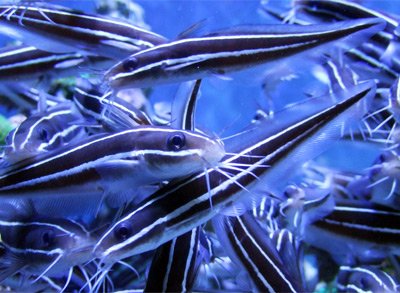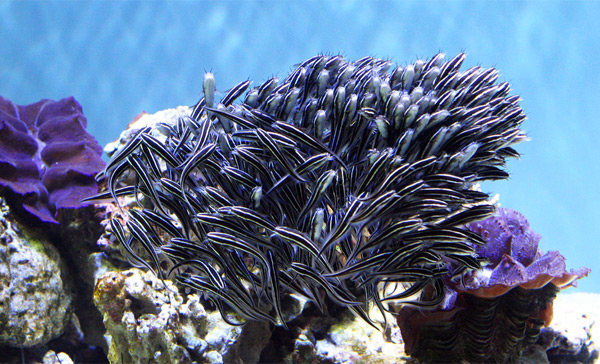A school of juvenile coral catfish (Plotosus lineatus) rolling and wriggling en masse along the ocean floor is among the more endearing sights one can behold in the marine realm. Not surprisingly, after seeing this phenomenon in nature or on video, many hobbyists are inspired to recreate it in their home aquaria. What’s more, individual juveniles of the species—the only catfish found on tropical coral reefs—are irresistibly cute, so even those hobbyists who have never observed their schooling behavior may be charmed by them at a local fish store.
But before yielding to temptation and acquiring P. lineatus for your tank, it’s important to be aware of some key facts with respect to its growth potential, social behavior, and defensive capability. So, let’s take a closer look at these and other characteristics exhibited by this species.
Coral cats and CJS
The coral catfish, aka the striped eel catfish or saltwater catfish, is one of several fish species available in the marine aquarium trade that exhibit what I (as of this morning) like to call Cute-Juvenile Syndrome, or CJS. That is, they start off life as adorable, gregarious little juveniles—enticing to hobbyists—but morph into big, drab, decidedly less cute and sociable adults.
Juveniles are brown to black on their dorsal half and white on their ventral half. They also have whitish to yellowish horizontal stripes originating at the snout, running the length of the body, and terminating at the caudal fin. In adults, the overall coloration becomes more dull brown and the stripes fade significantly. Four pairs of barbels (whiskers) surround the mouth, and the dorsal and anal fins are continuous with the caudal fin, hence the “eel catfish” moniker. Maximum length for this species is over a foot.

Venomous spines
It’s critical to be aware that P. lineatus has highly venomous spines in its dorsal and pectoral fins. Stings are said to be excruciatingly painful (though, as discussed in a prior post, individual reactions to such envenomations will vary and can be extremely difficult to qualify), so considerable caution must be exercised when capturing/transferring this species or working within the same tank. If a sting should occur, it’s well advised to seek prompt medical attention.
Feeding
The coral catfish is an omnivore, its natural diet including crustaceans, mollusks, worms, and small fish as well as algae and detritus. Captive specimens are very easy to feed and will accept a wide variety of fresh, frozen, and dry foods with little coaxing. Twice-daily feedings are recommended.
Housing
Coral catfish should be kept in groups as juveniles but become more solitary and reclusive as adults. This poses something of a quandary with respect to determining appropriate tank size for this species. A small group of juveniles or a single adult could be kept in a moderately large tank, say in the vicinity of 100 gallons or so, with a good-sized bed of fine sand. But a group of juveniles allowed to mature into adulthood together would require a very large tank indeed in order to provide enough room for individual territories and refuges, a sufficiently sized sand bed to grub in, as well as adequate dilution of their copious waste.
Compatibility
Any fish tankmates kept with P. lineatus must be too large to swallow, and ornamental crustaceans should be excluded, as they are certain to become a costly meal.
As far as sessile invertebrates are concerned, this catfish isn’t a direct threat. However, owing to its habit of grubbing constantly in the sand (potentially creating “sandstorms” that can settle upon and irritate corals, clams, and other inverts) and the significant amount of dissolved waste it produces, P. lineatus is a generally poor choice for reef systems.




